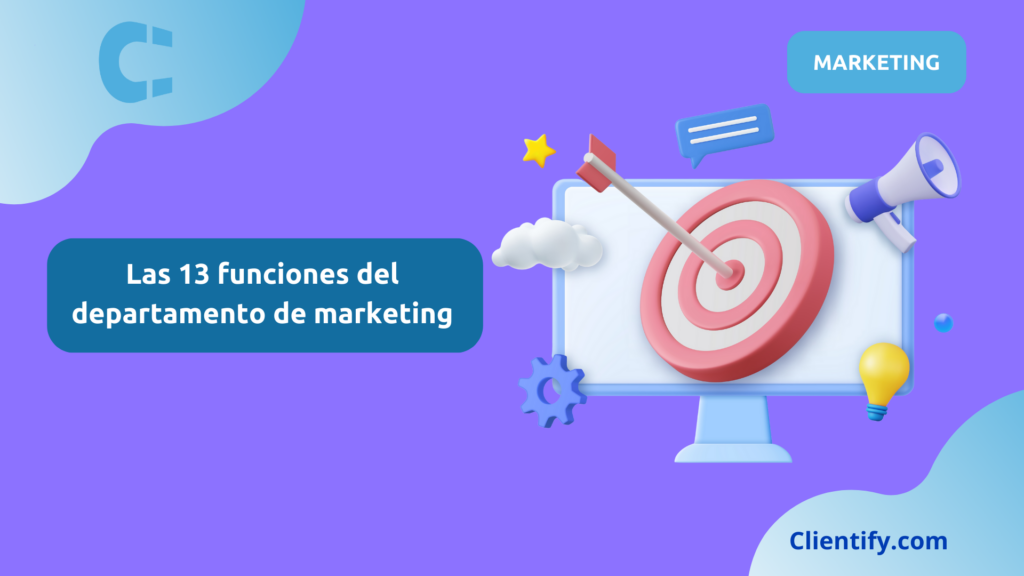The marketing department is the engine that drives the visibility, customer acquisition and growth of any company. Its functions range from market research to product innovation, advertising, digital marketing and customer loyalty.
Knowing what the main marketing functions are will allow you to understand how each one brings value to your business and how to optimize them with advanced tools such as a CRM.
The 13 functions of the marketing department are:
- Market research
- Product development
- Market segmentation and positioning
- Pricing strategies
- Promotion and advertising
- Brand management
- Public relations and corporate communications
- Digital marketing
- Relationship marketing and CRM
- Sales management and distribution channels
- Results analysis and ROI
- Innovation and development of new opportunities
- Training and development of the marketing team
Market research: the basis of every strategy
Market research allows you to thoroughly understand customers, competitors and trends to make decisions with less intuition and more data. Done well, it feeds segmentation, positioning and even the product roadmap.
Key methods (quick to activate):
- Surveys and interviews (problems, objections, reasons for purchase).
- Focus groups / concept testing (message, value proposition, pricing).
- Analysis of digital trends (searches, forums, networks, reviews).
- CRM internal data (cycles, win/loss, cohorts, LTV by segment).
Key fact: companies that leverage customer insights outperform their peers by 85% in sales growth and more than 25% in gross margin. McKinsey & Company
If you are looking to optimize this feature, we recommend starting your free trial on Clientify with our advanced CRM tools that make it easy to collect and analyze data.
Practical tip: document a “one-pager of insights” by segment (problems, purchase triggers, objections, persuasive messages and intent signals) and connect it to your CRM so that sales and marketing work with the same truth.
Product development
Product development is one of the most important functions of marketing; it consists of creating, improving or adapting goods and services that respond to the needs detected in market research. This marketing function connects directly with innovation and sales: what is designed must be viable, attractive and competitive.
Key tasks of product development in marketing:
- Opportunity identification → analyze market gaps or new trends.
- Proof of concept and prototyping → validate if the proposal solves the customer’s problem.
- Collaboration with R&D and operations → ensure product is feasible and scalable.
- Launching and positioning → design campaigns that transmit the differential value.
- Continuous customer feedback → use CRM data to adjust features.
According to our marketing strategy manual, the next step is to document a continuous improvement cycle in your CRM:
- Customer Insight
- Proposal for improvement
- A/B or pilot test
- Adjustment and relaunch
Market segmentation and positioning
Market segmentation consists of dividing the public into smaller, homogeneous groups according to their characteristics, interests or behaviors.
Positioning, on the other hand, is the perception that customers have of your brand compared to the competition.
Together, they are the compass of any marketing strategy.
Most common types of segmentation:
- Behavioral → purchasing habits, product usage, loyalty.
- Demographic → age, sex, income level, education.
- Geographic → country, region, city or even neighborhood.
- Psychographic → interests, values, lifestyle.
If you need help defining your market positioning, you can schedule a free demo with our experts.
Practical example:
- A sportswear brand can segment into “25-40 year old urban runners” and position itself as “the lightest and toughest option for city running”.
- In B2B, a SaaS company like Clientify can segment SMBs in education and position itself as “the CRM that engages and converts more students with WhatsApp and AI.”
Practical tip: define a simple positioning map (axes: price vs. perceived value, innovation vs. tradition) to visualize where your brand is and where your competitors are. This way you can find a unique space in the consumer’s mind.
Pricing strategies and value perception
Price is one of the most decisive factors in the purchase decision. A well-designed pricing strategy not only ensures profitability, but also builds value perception around the brand.
Types of common pricing strategies:
- Competitive prices → adjusted to what the market offers.
- Value-based pricing → what the customer perceives it to be worth, not what it costs to produce.
- Dynamic pricing → adapted to demand, season or customer behavior.
- Discounts and promotions → tactics to attract new customers or build customer loyalty.
- Premium strategies → higher prices to reinforce exclusivity and quality.
before defining prices, validate three factors:
- Business objective (capture market share fast or maximize margin?).
- Elasticity of demand (how does your customer react if you raise/lower the price).
- Perception of value (what do they think they are buying beyond the product?).
Promotion and advertising: giving visibility and persuading
Promotion and advertising, more than marketing functions, are the loudspeaker of marketing: they make the product stop being invisible and start occupying space in the consumer’s mind.
Today, the promotional mix combines traditional and digital:
- An advertisement on social networks can trigger notoriety in a matter of hours.
- A search engine marketing (SEM) campaign attracts those who are already looking for a solution.
- Offline advertising continues to have weight in certain sectors (local radio, trade fairs or specialized press).
The important thing is to choose where your customer is and make sure that the message is adapted to that context.
📌 One key point: consistency. Advertising works best when the message is consistent across all formats. If on social networks you talk about closeness and agility, your ad on Google cannot sound cold and generic.
A common mistake is to think that promotion is only investment in ads, in reality, it also includes low-cost actions with great return:
- Media appearances (digital PR).
- Segmented email campaigns.
- Viralizable content that fulfills the same function as an ad, but without paying for the space.
The question that should always guide this function is: what do I want people to think and do when they see this message, that is the real advertising strategy .
6. Brand management
Brand management is not about colors or pretty fonts, but about the promise you make and keep every time someone comes in contact with your company .
It is the sum of experiences: what a customer reads on your website, how you serve them with support, how they feel about using your product.
A well-managed brand gets customers to think of you first, even before they compare prices. That’s why companies like Apple or Nike don’t compete on discounts: they sell meaning, trust and lifestyle.
On a day-to-day basis, brand management translates into:
- Consistency → make your communication sound the same on social networks, emails or commercial calls.
- Reputation → respond quickly and honestly to criticism or crises.
- Identity → clearly convey what makes you different from others.
📌 A concrete example: when an SME gets its customers to talk about it as “the company that always responds on time”, that perception is part of its brand value, and can outweigh price in the purchasing decision.
In today’s digital environment, brand management also means keeping an eye on how you appear on Google, what they say about you in reviews and what image your content projects.
Every interaction adds or subtracts points to your brand, and the marketing department is the keeper of that invisible score.
7. Public relations and corporate communication
When it comes to “public relations”, many people think of boring press releases or formal events with politicians and journalists.
The reality is much simpler: it is all the actions that make your company be liked and remembered, it is one of the functions of marketing.
You don’t have to be a multinational to work with them. An SME can start with things as simple as:
- Send an announcement when a new product is launched.
- Respond quickly to customer comments on social networks.
- Provide industry data or trends to a local media outlet.
Corporate communication comes into play when you need your message to be consistent inwardly and outwardly.
Let your team, your customers and even your suppliers understand the same about who you are and what you promise.
An example: imagine a tech startup hosting a free webinar on how to sell more in digital.
This action is public relations, because it brings value to the community and improves the perception of the company without the need to talk directly about “buy my product”.
The key is to think, “If someone writes about us in a newspaper tomorrow, what would we want them to say?”
Everything you do in PR and communication should work to make that phrase positive and credible.
Digital marketing: where the real battle takes place
Today, most of the visibility is played in the digital arena. Digital marketing is not just another “channel”, it is the space where your customers search, compare and decide.
How do you land on a day-to-day basis?
Online reputation → reviews, forums and comments are as influential as a campaign. Managing them in time avoids losing customers in silence.
SEO → when someone searches for “best CRM for SMEs” your brand appears at the top. The winner here is the one who publishes useful content, answers questions and keeps the website fast.
Email marketing → the inbox is still gold. Targeted campaigns with personalized messages generate much cheaper sales than advertising.
Social media → posting for the sake of posting is not enough. A clear strategy (e.g. LinkedIn to capture B2B leads, Instagram to reinforce visual branding) is the difference between noise and results.
Online advertising (SEM/Display) → Google Ads and Meta Ads allow you to target ready-to-buy customers. The trick is not to burn budget with audiences that are too broad.
Relationship marketing and CRM: from a one-time sale to a customer for life
Relationship marketing seeks more than just closing sales: it wants customers to stay, repeat and recommend. And that’s where a CRM like Clientify makes the difference.
With Clientify, every interaction with a customer is recorded in one place: calls, emails, WhatsApp, meetings or even the first time they filled out a form on your website. This traceability allows you to personalize the relationship and follow up effortlessly.
Real-life examples with Clientify
- Follow-up automation: if a lead downloads a guide on your website, Clientify can automatically send them a welcome email, assign them to a salesperson and, if they don’t respond, send them a WhatsApp three days later.
- Loyalty campaigns: you can segment customers by behavior (e.g. those who have not purchased in 6 months) and launch specific campaigns to reactivate them.
- Multichannel experience: everything happens in the same inbox: mail, networks and native WhatsApp, without having to jump from tool to tool.
📌 The result: fewer lost customers, more long-term relationships and a sales team that spends time selling instead of chasing repetitive tasks.
A well-implemented CRM can transform the way your company manages customer relationships, and if you don’t have one yet, we invite you to try our CRM solutions.
Sales and distribution channel management: organization and clarity
Sales management is not just about “closing deals”: it involves knowing which channel brings in the most customers, at what stage opportunities get stuck and which actions accelerate conversion.
This is where marketing and sales intersect, and a CRM like Clientify becomes the tool that sorts through the chaos.
How Clientify helps in sales management
Multi-channel management → all leads enter the same CRM, regardless of whether they come from a landing page, a network ad or an in-person trade show.
Visual pipelines → each opportunity appears in an easy-to-read sales funnel, from the first contact to the close. This allows you to detect bottlenecks instantly.
Task automation → follow-up reminders, sending proposals or even automatic WhatsApp messages when a lead advances a stage.
Real-time reporting → clear metrics: which channel (web, LinkedIn, email, calls) converts the most, what is the average ticket and how long does it take to close a sale.
Performance analysis and ROI: when marketing is measured in numbers
Marketing is of little use if it does not translate into results. Therefore, one of the most critical functions of the department is to measure what works, what doesn’t and what return the actions generate.
Here we are not just talking about likes or visits, but indicators that connect directly with the business:
- Attraction KPIs → web visits, ad click-through rate, network reach.
- Conversion KPIs → leads generated, forms completed, opportunities created.
- Sales KPIs → cost per acquisition (CAC), customer lifetime value (LTV), close rate.
- ROI (return on investment) → how much money each euro invested in marketing returns.
If an email campaign costs €1,000 and generates sales of €5,000, the ROI is 400%. That figure says much more than any vanity metric.
In addition to the immediate ROI, it is worth analyzing:
- Trends over time → is the cost per lead going up or down?
- Channel comparison → which channel generates more profitable customers?
- Indirect impact → reputation, brand recall, organic traffic gained in the long term.
Analysis is not the end, but the beginning: every piece of data should be used to make smarter decisions and reallocate resources to what really works.
Innovation and development of new opportunities
The marketing department also plays a key role in identifying new business opportunities and innovation. This may include expanding into new markets, developing new products, or implementing new technologies and trends.
The ability to innovate and adapt quickly to market changes is crucial to remain competitive.
Marketing not only executes campaigns, it also has the ability to detect where the market is going and open doors to new lines of business. Many times, opportunities are not born in a product laboratory, but from what marketing observes in customers, competitors and trends.
Training and development of the marketing team
Tools change, algorithms change, platforms change.
The only thing that can keep up is the team.
A strong marketing department is not only measured by successful campaigns, but by the ability of its people to learn and adapt.
- An SEO specialist who understands analytics.
- A creative that also masters data.
- A campaign manager who knows how to automate processes.
Such hybrid profiles do not appear out of nowhere: they are formed.
Investing in continuous training means:
- Time dedicated to testing trends without fear of failure.
- Courses and certifications in new disciplines.
- Internal spaces to share learning.
The 13 functions of Marketing – Conclusion
The marketing department plays a multifaceted role ranging from market research to brand management and innovation.
Each of these functions is essential to the overall success of the company, and together, they form a comprehensive strategy that drives growth and competitiveness in the marketplace.
If you would like to optimize any of these functions, do not hesitate to start your free trial with our tools, designed to boost the performance of your marketing department.
Do it all with Clientify: engage, automate and close sales
Enter for free in the space where Clientify users share tips, help each other and learn how to sell more with AI.
Share your doubts and learn with others who are also growing their business.





